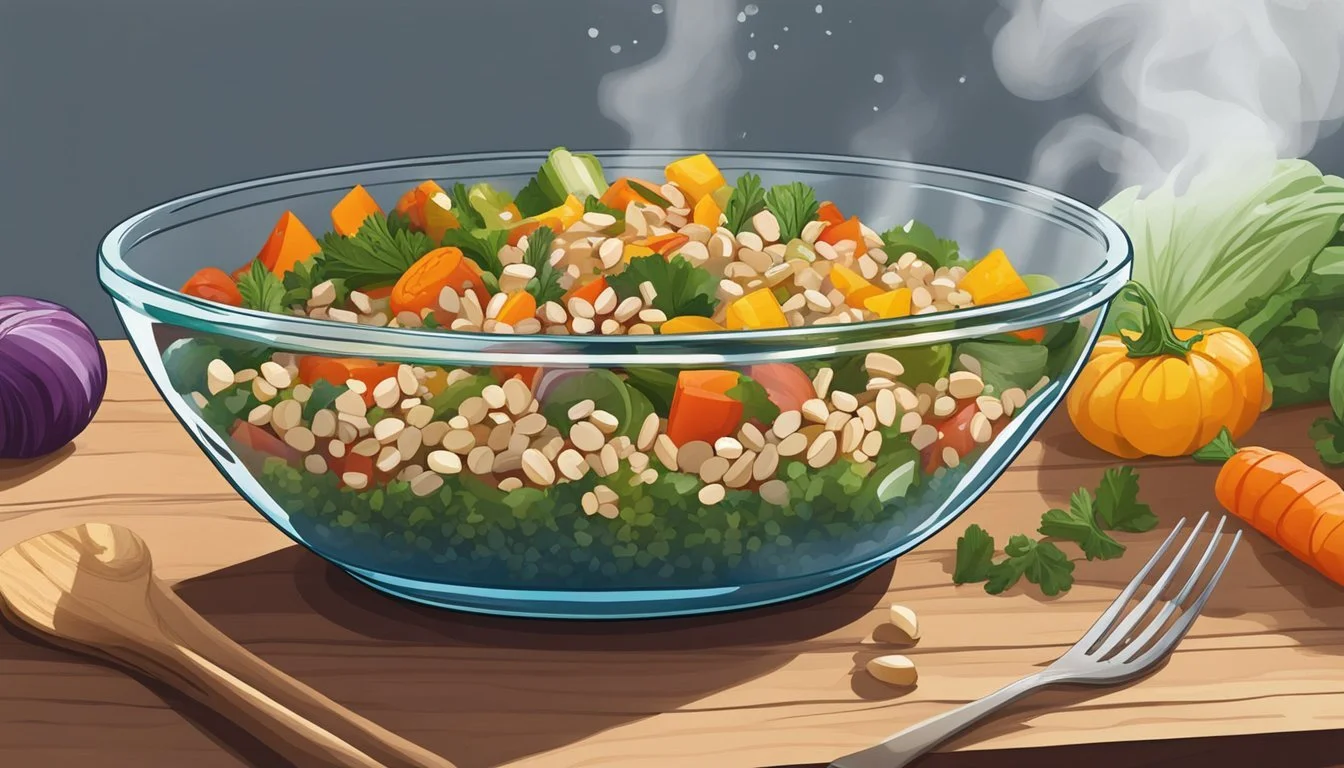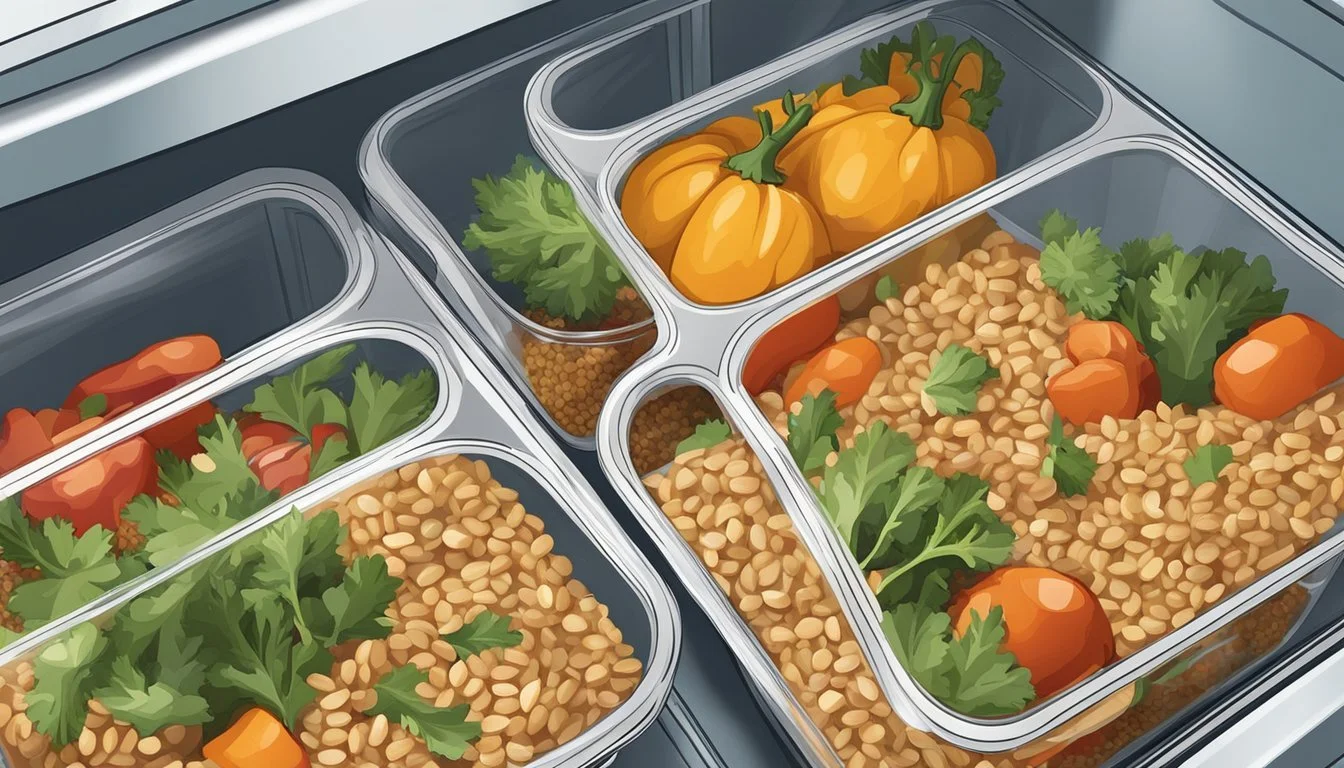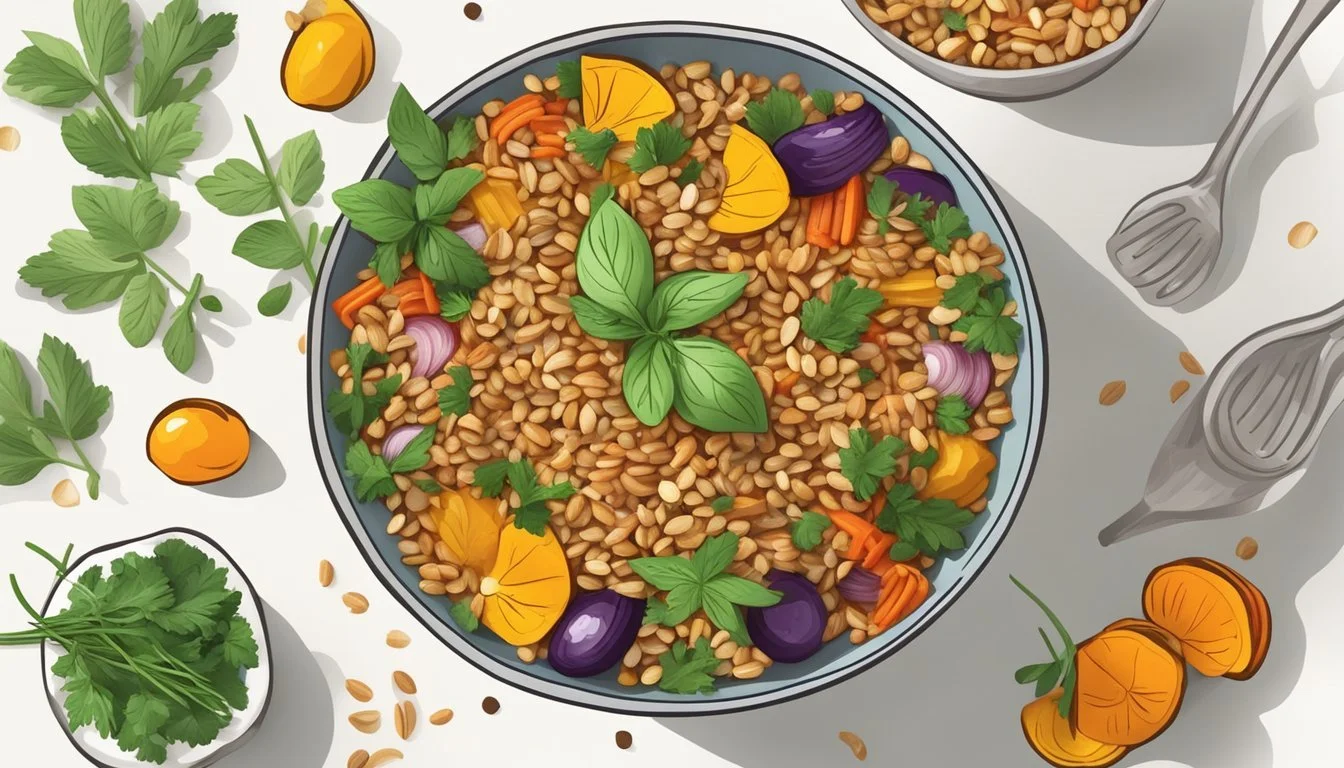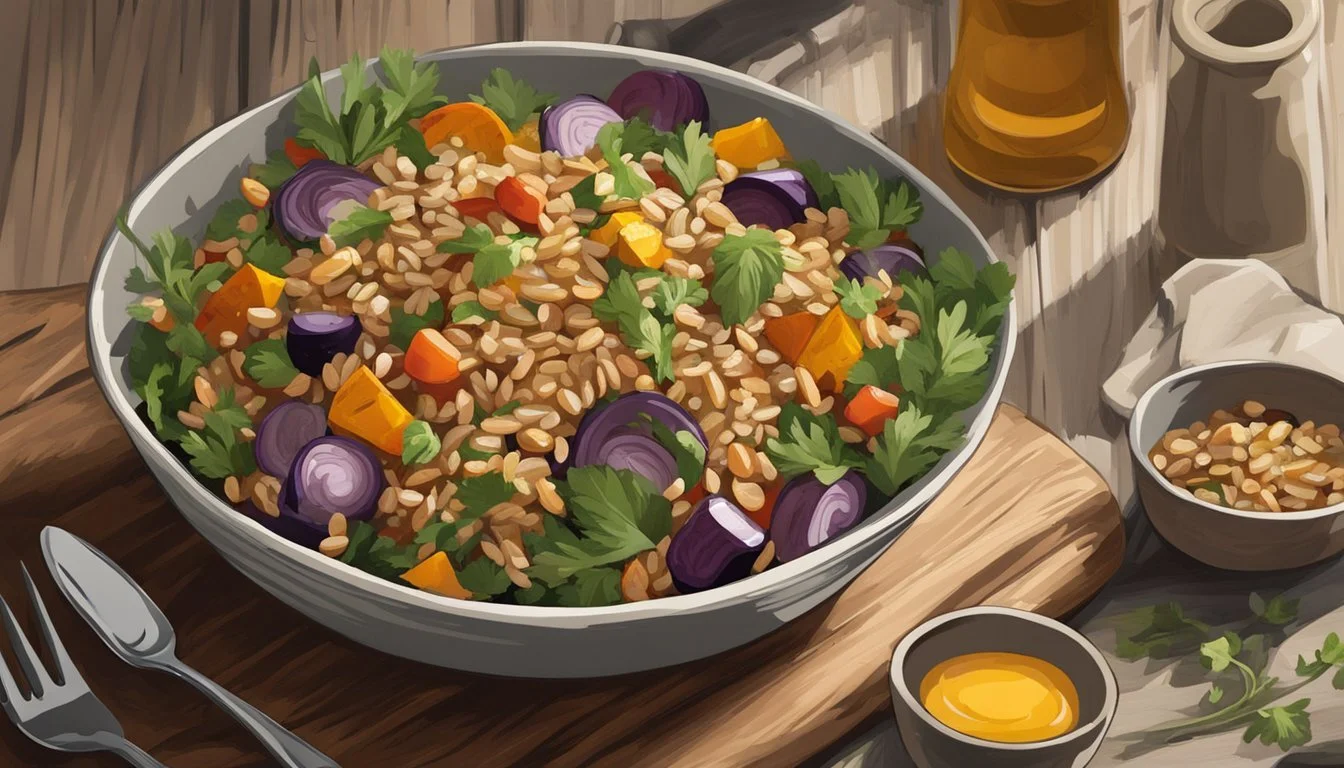Best Way to Reheat Farro Salad with Roasted Vegetables
Tips for Preserving Freshness and Flavor
Farro salad with roasted vegetables is a nutritious and hearty dish that is as versatile as it is delicious. The combination of chewy farro and caramelized vegetables creates a perfect balance of textures and flavors that make it a favorite for meal prep enthusiasts and health-conscious diners alike. However, the challenge often arises when it comes to reheating this dish. The key to reviving leftovers lies in preserving the fresh taste and texture of both the farro and the roasted vegetables.
The best method for reheating farro salad begins with gentle heat and involves retaining moisture to prevent the grains and vegetables from drying out. Since it is a dish that includes ingredients with different reheating needs, understanding how to properly restore its warmth while maintaining its original quality is crucial. Techniques vary from stovetop simmering to the strategic use of microwave ovens, each method carrying its special nuance to ensure the salad returns as close to its freshly made state as possible.
Maintaining the freshness and flavor of a farro salad with roasted vegetables when reheating requires careful attention to detail. The process should enhance its rich earthy tones and aromatic spices rather than diminish them. A successful reheat not only revitalizes the dish’s temperature but also invigorates its inherent flavors, ensuring that each bite is as satisfying as when it was first prepared.
Understanding Farro
Before delving into the best methods for reheating farro salad, it's essential to grasp what farro is and why it stands out among grains. This section will discuss the basics of farro and its health benefits.
Farro Basics
Farro refers to the grains of certain wheat species and is often considered an ancient grain, appreciated for its hearty texture and nutty flavor. Unlike more commonplace grains like wheat or rice, it retains a notable bite and structure even after cooking. It comes in three types: einkorn (farro piccolo), emmer (farro medio), and spelt (farro grande), which differ slightly in terms of size, flavor, and nutritional properties.
Farro is typically soaked overnight to reduce cooking time and then boiled in water or broth until it reaches a tender yet chewy consistency. This process usually takes around 25 to 40 minutes, depending on the specific type of farro.
Health Benefits
As a nutritious, whole grain, farro offers an array of health benefits. It's a rich source of fiber, which promotes digestive health and can aid in maintaining a healthy weight. Fiber helps in making one feel full, which can reduce overall calorie intake.
In addition, farro is packed with protein, making it an excellent ingredient for plant-based diets. A 1/4-cup serving of dry farro typically provides around 7 grams of protein. Farro also includes a variety of nutrients such as magnesium, zinc, and some B vitamins.
Nutritional Table for Farro (per 1/4 cup dry):
Nutrient Amount Calories 170 Protein 7g Fiber 7g Fat 1g Carbohydrates 34g
By incorporating farro into one's diet, an individual benefits from an ancient grain that has been a reliable food source for thousands of years. It's versatile enough to be included in both sweet and savory dishes, making it an adaptable ingredient for various cuisines.
Selecting Ingredients for Farro Salad
The foundation of an exceptional farro salad rests on high-quality, fresh ingredients. Careful selection of both vegetables and grains elevates the dish, ensuring a blend of flavors and textures that pleases the palate.
Choosing Vegetables
For a farro salad, opt for a medley of root vegetables like carrots and red onions which caramelize beautifully when roasted, providing a sweet and savory profile. Vegetarians also enjoy the nutritious benefits that these vegetables impart. One should consider the following:
Carrots: Choose firm, bright orange carrots devoid of blemishes.
Red Onion: Look for onions with a tight, papery skin, indicating freshness.
Adding olive oil and seasoning the vegetables properly before roasting can further bring out their inherent sweetness and earthy tones. Additionally, fresh parsley can be incorporated as a garnish to add a burst of color and a fresh, herbal note.
Selecting the Right Farro
Not all farro is created equal. This ancient grain comes in three forms: pearled, semi-pearled, and whole. In the context of a salad, semi-pearled farro strikes a balance between nutrition and convenience, as it retains some of the bran for nutritional value but cooks faster than whole farro. One should ensure that the farro is:
Semi-pearled: It contains more fiber and nutrients than pearled varieties.
Fresh: Grains should not be stale or have an off-smell, signaling that they are past their prime.
When cooked, farro should be tender yet chewy, providing a satisfying base for the salad that complements the roasted vegetables.
Preparing Farro Salad
The process of preparing Farro Salad hinges on three main components: properly cooking the farro for the right texture, roasting vegetables to enhance their flavor, and assembling the salad with a balanced mix of these components.
Cooking Farro
Ingredients:
1 cup farro
Salt (to taste)
Water for boiling
Instructions:
Start by boiling the farro in lightly salted water. It typically takes about 25-30 minutes to cook farro until it's tender yet still has a slight chewiness.
Once the farro is cooked, drain the excess water using a strainer, and set the farro aside to cool.
Roasting Vegetables
Ingredients:
Selection of root vegetables (e.g., carrots, sweet potatoes, squash)
Olive oil
Salt and pepper (to taste)
Optional: rosemary, garlic, paprika
Preparation Time: Approximately 10 minutes
Instructions:
Preheat the oven to between 375°F and 400°F.
Cut the vegetables into uniform pieces and toss them in a bowl with olive oil and desired seasonings until coated.
Spread the vegetables out on a baking sheet in a single layer to ensure even roasting.
Place the baking sheet in the oven and roast the vegetables. This takes around 30-55 minutes depending on the oven temperature and vegetable types.
Halfway through the baking process, flip or toss the vegetables to achieve an even roast and caramelization.
Assembling the Salad
Ingredients:
Cooked and cooled farro
Roasted vegetables
Additional elements (e.g., cherry tomatoes, nuts, greens like arugula)
Dressing (optional)
Instructions:
In a large bowl, combine the cooked farro with the roasted vegetables.
Add any additional salad components like fresh cherry tomatoes or nuts for texture and flavor.
If using dressing, pour it over the farro and vegetables and toss to ensure the salad is well coated.
Serve the salad on its own or on a bed of greens such as arugula for an added fresh element.
Reheating Farro Salad
Reheating Farro Salad properly is paramount to maintaining its texture and flavor. The challenge lies in warming the farro and roasted vegetables without drying them out or making them soggy.
Using the Oven
To reheat Farro Salad in the oven, one should preheat the oven to 350 degrees Fahrenheit. They need to spread the farro and roasted vegetables on a baking sheet lined with parchment paper—this aides in preventing sticking and ensures even warming. Covering the salad with foil can help retain moisture. It should take about 10-20 minutes depending on the oven and the desired temperature throughout the salad.
Preheat oven to 350°F.
Arrange Farro Salad on a lined baking sheet.
Optionally, cover with foil to retain moisture.
Heat for 10-20 minutes until thoroughly warm.
Microwave Method
The microwave can be used for a quicker reheating process. To retain the salad's moisture, one can cover the salad with a damp paper towel while microwaving. They should use a microwave-safe container and heat the salad in increments of 30 seconds, stirring in between to ensure even heating without overcooking.
Use a microwave-safe container.
Place a damp paper towel over the salad.
Heat in 30-second intervals, stirring in between.
Remember, different components retain heat differently, so attention to detail is crucial in both reheating methods to ensure the Farro Salad retains its fresh and flavorful qualities.
Storing Farro Salad
When storing farro salad with roasted vegetables, ensuring it retains its freshness and flavors is key. The salad should never be left at room temperature for extended periods after initial serving. Using the right storage methods will maintain the quality whether it's for lunch (What wine goes well with lunch?), dinner, or as a side dish.
Airtight Containers
To properly store farro salad, one should always use airtight containers. These containers prevent excess moisture and air from altering the texture and flavor of the farro and vegetables. For best results:
Select containers that are just the right size for the salad portion to minimize the amount of trapped air.
Press down the salad gently before sealing to eliminate air pockets.
Refrigeration Tips
For refrigeration, adhere to these specific practices:
Cool the farro salad to room temperature before refrigerating to avoid condensation within the container.
Store the salad in the coldest part of the refrigerator, typically at the back, to maintain an even temperature.
As a time-saving tip, store individual portions in separate containers for a quick grab-and-go lunch or dinner option.
Enhancing the Salad
To revitalize a farro salad with roasted vegetables and amplify its flavors, focus on the dressing and seasoning, and the addition of cheese and herbs.
Dressing and Seasoning
Using the right dressing can make a substantial difference in refreshing a farro salad. A homemade vinaigrette with a base of extra-virgin olive oil and balsamic vinegar or lemon juice not only adds brightness but also enhances the roasted flavors of the vegetables. Whisk together these liquids and introduce sea salt and freshly ground black pepper for a simple yet effective dressing. Adjust the ratios to taste; typically aim for three parts oil to one part vinegar or lemon juice for balance.
Olive Oil: 3 parts
Vinegar/Lemon Juice: 1 part
Salt and Pepper: To taste
Cheese and Herbs
Incorporating cheese into the salad introduces a new layer of complexity. Goat cheese is a creamy and tangy option that pairs well with the nuttiness of farro and the sweetness of roasted vegetables. Crumble it over the salad before serving.
Herbs bring a fresh dimension and should be selected to complement the existing flavors. Basil can be torn and scattered throughout for a hint of pepperiness, while other herbs like oregano or tarragon could be finely chopped and mixed in to infuse their aromas.
Goat Cheese: Crumbled
Fresh Herbs: Torn or chopped
Farro Salad Variations
When looking to enhance or alter the composition of a farro salad, a cook might consider adding various proteins or alternative grains. These adjustments can cater to different dietary needs and preferences, as well as provide nutritional benefits.
Introducing Proteins
Incorporating proteins into a farro salad transforms it from a side dish to a hearty main course. For those who eat meat, grilled chicken is an excellent choice, adding lean protein that complements the salad's earthy flavors. Not only does chicken offer a substantial protein boost, but it also provides essential nutrients like iron. For vegetarians, options like tofu or chickpeas can be used. They are both rich in protein and integrate well with the existing flavors of the salad.
Recommended Protein Additions:
Chicken: Grilled and sliced breast or thigh
Tofu: Firm, pressed, and cubed
Chickpeas: Cooked and seasoned
Alternative Grains
While farro is a nutritious whole grain loaded with fiber, some may prefer or require gluten-free alternatives. Quinoa is a versatile and popular choice that offers a complete protein profile, containing all nine essential amino acids. It is also a fantastic source of iron. Brown rice is another alternative; it has a chewy texture that holds up well in salads (What wine goes well with salads?) and provides essential vitamins and minerals. Both grains are gluten-free, making them suitable for those with gluten sensitivities or celiac disease.
Grain Substitutions:
Quinoa: Cooked until translucent and tails unfurl.
Rice: Use brown rice for a chewier texture and nuttier flavor.
Nutritional Information
When reheating farro salad with roasted vegetables, it is important to consider the nutritional profile of the dish. This dish provides a wholesome balance of macronutrients and is rich in fiber, which can vary depending on the selection of vegetables included.
Caloric Breakdown
Calories: A serving size of farro salad paired with a variety of roasted vegetables typically ranges from 200 to 400 calories.
Fat: Healthy fats are present due to olive oil used in roasting, with minimal amounts of saturated fat and no cholesterol.
Fiber: Farro is a high-fiber grain, contributing to the total dietary fiber in the dish, which aids in digestion and satiety.
Carbohydrates: The dish is a source of complex carbohydrates, essential for providing sustained energy.
Protein: Farro also adds protein to the meal, important for muscle repair and growth.
Diet Friendly Options
For individuals monitoring their nutrition intake:
Low-Fat: To reduce fat content, one can use less olive oil or opt for a spray.
Low-Sodium: Selecting fresh vegetables and limiting added salt can help maintain a low sodium profile.
Antioxidant-Rich: Including a colorful array of vegetables increases the antioxidant content, which can help combat oxidative stress.
Healthy Carbohydrates: Farro, being a whole grain, contains complex carbohydrates that are healthier compared to refined grains.
When enjoying farro salad with roasted vegetables, one can appreciate not only its flavors but also its contribution to a balanced diet.
Serving Suggestions
When reheating Farro Salad with Roasted Vegetables, one should consider whether it will be served as a main course or as an accompanying side dish. Each serving method offers different possibilities for meal prep, lunch, or dinner, and can be adapted to complement soups, salads, or other sides.
As a Main Course
In the role of a main course, Farro Salad with Roasted Vegetables provides a hearty and nutritious option. It can be served warm, making it especially fitting for cooler days or for a satisfying lunch that is both filling and flavorful. For a complete meal:
Servings: Aim for about 1 to 1.5 cups of the reheated salad per person.
Accompaniments: Consider a simple soup or fresh green salad to start.
Meal Prep: Divide the salad into single servings for an easy grab-and-go lunch option during the week.
As a Side Dish
Farro Salad with Roasted Vegetables excels as a companion to a variety of main dishes, thanks to its versatility and rich flavor profile. As a dinner component:
Pairings: Serve alongside grilled chicken, fish, or a plant-based protein.
Portion Size: Approximately 1/2 to 3/4 cup per person should suffice.
Additional Sides: Complementary sides might include a leafy salad or a steamed vegetable medley.
Additional Tips
Retaining the freshness and enhancing the flavors in a reheated farro salad with roasted vegetables require a few purposeful strategies. These tips focus on meal prepping to facilitate ease and how to infuse creativity into the dish to elevate its appeal and taste.
Meal Prepping
Meal prep is crucial for maintaining the texture and flavor of a farro salad. When preparing farro in advance, it's wise to cook it al dente to avoid a mushy texture upon reheating. Store the farro and vegetables separately in the fridge. This maintains the integrity of each component. For reheating, one can simply place the farro on a plate and lightly steam or microwave it, stirring occasionally to ensure even warmth.
Meal Prep Stage Tips Cooking Farro Cook until just tender; usually takes about 25-30 minutes. Storing Farro Let it cool before refrigerating; use within 3-5 days for best texture. Storing Vegetables Keep them in an airtight container; they remain vibrant for 3-4 days. Reheating Add a touch of water or stock to avoid dryness, cover, and reheat gently.
Creativity in the Kitchen
Remaining creative in the kitchen keeps the reheated farro salad interesting with each serving. One can enhance the salad by introducing new toppings like lemon zest for a citrusy kick or tossing in dried cranberries for a sweet and tart contrast. If the salad is part of a larger menu, consider incorporating it into a soup for a heartier dish. Adding finely chopped rosemary can infuse an aromatic depth to the flavor profile without overpowering other ingredients. Experiment with different condiments and fresh herbs, but always taste before serving to achieve the perfect balance.
Ingredients Purpose Lemon Brightens the dish with a fresh, citrus flavor. Dried Cranberries Introduce a chewy texture and a sweet-tart flavor. Rosemary Adds a piney aroma and earthiness to the farro. Soup Inclusion Transforms the salad into a comforting, warm meal.











